Practicing the CBSE Sample Papers for Class 10 Maths Standard Set 7 allows you to get rid of exam fear and be confident to appear for the exam.
CBSE Sample Papers for Class 10 Maths Standard Set 7 with Solutions
Section – A
Question 1.
What is the smallest composite number?
(a) 1
(b) 2
(c) 3
(d) 4
Answer:
(d) 4
Explanation: The smallest composite number is 4.
Question 2.
If the H.C.F. of two numbers is 1, then the two numbers are called :
(a) composite
(b) twin primes
(c) co-primes
(d) none of these
Answer:
(c) co-primes
Explanation: Two numbers are said to be co-primes if they have only one common factor, namely 1.
![]()
Question 3.
If a and p are zeroes of x2 + 5x + 8, then what will be the value of (α + β )?
(a) 5
(b) -5
(c) 8
(d) -8
Answer:
(b) – 5
Explanation: If α and β are zeroes of the given equation than α + β is given by :
α + β = \(\frac { -b }{ a }\)
From the given equation a = 1, b =5 and c = 8
So, α + β = \(\frac { -b }{ a }\) = \(\frac { -5 }{ 1 }\) = -5
Question 4.
For what value of k the system of equations x + 2y – 3 = 0 and 5x + ky + 7 = 0 has no solution?
(a) 10
(b) – 10
(c) 2
(d) None of these
Answer:
(a) 10
Explanation: The given system of equation is
x + 2y – 3 =0
5x + ky + 7 = 0
For no solution, we must have \(\frac{a_1}{a_2}\) = \(\frac{b_1}{b_2}\) ≠ \(\frac{c_1}{c_2}\)
Here, a1 = 1, a2 = 5, b1 = 2, b2 = k, c1 = -3, c2 = 7
\(\frac{a_1}{a_2}\) = \(\frac{b_1}{b_2}\)
⇒ \(\frac { 1 }{ 5 }\) = \(\frac { 2 }{ k }\)
⇒ k = 10
Now, \(\frac{b_1}{b_2}\) ≠ \(\frac{c_1}{c_2}\)
⇒ \(\frac { 2 }{ 10 }\) ≠ \(\frac { -3 }{ 7 }\)
Hence, for k = 10 the given system of equations has no solution.
Question 5.
What is the nature of the roots of the quadratic equation 4x2 – 12x – 9 = 0?
(a) real and distinct
(b) real and equal
(c) imaginary and distinct
(d) imaginary and equal
Answer:
(a) real and distinct
Explanation: Given equation is,
4x2 – 2x – 9 = 0
On comparing the given equation with ax2 + bx + c = 0, we get
a = 4, b = – 12 and c = – 9 Now,
D = b2 – 4 ac
= (-12)2 – 4(4) (- 9)
= 144 + 144 = 288
∵ D > 0
∴ Roots are real and distinct.
Question 6.
If α and β are the zeroes of α polynomial such that α + β = – 6 and αβ = – 4, then write the polynomial:
(a) x2 – 6x – 4 = 0
(b) x2 + 6x – 4 = 0
(c) x2 + 6x + 4 = 0
(d) x2 – 6x + 4 = 0
Answer:
(b) x2 + 6x – 4 = 0
Explanation: Given α + β = – 6
and αβ = – 4
∵ The quadratic polynomial whose zeroes are α and β is given by f(x) =x2 – (α + β)x + αβ.
∴ The polynomial is f(x) =x2 + 6x – 4 = 0.
Question 7.
For which value of p will the equation
(p2 – 1)x2 + px + q = 0
not be a quadratic equation?
(a) p = 1
(b) p = -1
(c) Both (a) and (b)
(d) p = 0
Answer:
(c) Both (a) and (b)
Explanation: If coefficient of x2 is 0, then
p2 – 1 =0
p2 = 1
p =± 1.
Question 8.
If the value of cos A is \(\frac { 4 }{ 5 }\), then what will be the value of tan A?
(a) \(\frac { 4 }{ 2 }\)
(b) \(\frac { 3 }{ 4 }\)
(c) \(\frac { 5 }{ 4 }\)
(d) None of these
Answer:
(b) \(\frac { 3 }{ 4 }\)
Explanation: Given,
cos A = \(\frac { 4 }{ 5 }\) = \(\frac { B }{ H }\)
Let, Perpendicular = K and Hypotenuse = 2K
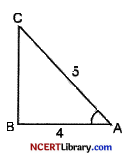
Base = \(\sqrt{H^2-B^2}\) = \(\sqrt{(5)^2-(4)^2}\) = \(\sqrt{25-16}\) = √9 = √3
tan A = \(\frac { P }{ B }\) = \(\frac { 3 }{ 4 }\)
Question 9.
If the value of cos A is \(\frac { 4 }{ 5 }\), then what will be the value of tan A?
(a) \(\frac { 5 }{ 3 }\)
(b) \(\frac { 5 }{ 4 }\)
(c) \(\frac { 4 }{ 3 }\)
(d) \(\frac { 3 }{ 4 }\)
Answer:
(d) \(\frac { 3 }{ 4 }\)
Explanation:
Given, cos A = \(\frac { 4 }{ 5 }\) = \(\frac { Base }{ Hypotenuse }\)
Applying Pythagoras theorem in △ABC, we obtain
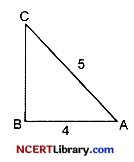
Perpendicular = \(\sqrt{(\text { Hypotenuse })^2-(\text { Base })^2}\)
= \(\sqrt{(5)^2-(4)^2}\)
= \(\sqrt{25-16}\)
= √9
= 3
∴ tan A = \(\frac { Perpendicular }{ Base }\)
= \(\frac { 3 }{ 4 }\)
Question 10.
The height of a tower is 12 m. Calculate the length of its shadow when Sun’s altitude is 45°:
(a) 12√3 m
(b) \(\frac{12}{\sqrt{3}} \mathrm{~m}\)
(c) 12 m
(d) None of these
Answer:
(c) 12 m
Explanation: Let AB be the tower and AO be its shadow.
In △OAB, tan 45° = \(\frac{\mathrm{AB}}{\mathrm{OA}}\)
⇒ 1 = \(\frac{\mathrm{AB}}{\mathrm{OA}}\)
⇒ OA = AB – 12 m
Hence, the length of shadow of the tower is 12 m.
Question 11.
For what value of p, the quadratic equation 2x2 + px + 3 = 0 has two equal roots?
(a) 8
(b) 5
(c) 2√6
(d) 6√2
Answer:
(c) 2√6
Explanation: For a given equation to have equal roots
D =0
i.e. D = b2 – 4ac
Here, b = p, a = 2, c = 3
⇒ p2 – 4 × 2 × 3 = 0
⇒ p2 – 24 = 0
⇒ p = √24 = 2√6
Hence, for p = 2√6 the given equation has equal roots.
Question 12.
The total surface area of a hemisphere of radius r is:
(a) πr2
(b) 2πr2
(c) 3πr2
(d) \(\frac { 2 }{ 3 }\)πr2
Answer:
(c) 3πr2
Explanation: Total area of hemisphere = Area of curved surface + Area of base
= 2πr(c) 3πr2 + πr(c) 3πr2 = 3πr(c) 3πr2
![]()
Question 13.
What is the HCF of 16 and 32?
(a) 16
(b) 32
(c) 8
(d) 24
Answer:
(a) 16
Explanation: HCF of (16, 32)
Prime factors of 16 =2 × 2 × 2 × 2
Prime factors of32=2 × 2 × 2 × 2 × 2
Hence, HCF (16, 32) = 2 × 2 × 2 × 2 = 16
Question 14.
The length of the tangent from a point A at a distance of 5 cm from the centre of the circle is 4 cm. What will be the diameter of the circle?
(a) 6 cm
(b) 9 cm
(c) 5 cm
(d) 4 cm
Answer:
(a) 6 cm
Explanation: Given : OA = 5 cm and AB = 4 cm
In △OBA, ∠B – 90° [ ∵ Tangent to a circle makes 90° with the radius]
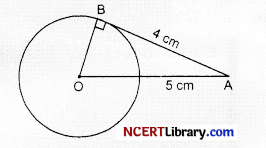
Therefore, by using Pythagoras theorem,
OA2 = OB2 + AB2
⇒ 52 = OB2 + 42
⇒ 25 – 16 = OB2
⇒ OB = 3 cm
∴ Diameter of circle = 2 × OB = 6 cm
Question 15.
If HCF (336, 54) = 6, find LCM (336, 54):
(a) 3042
(b) 3024
(c) 2403
(d) 4456
Answer:
(b) 3024
Explanation: We know, LCM (336, 54) = \(\frac { Product of two numbers }{ HCF (336, 54) }\)
= \(\frac{336 \times 54}{6}\) = 3024
.’. LCM (336, 54) = 3024
Question 16.
Find the value of k if the sum of the zeroes of the quadratic polynomial x2 – (k + 6)x + 2(2k + 1) is half of their product.
(a) 7
(b) 4
(c) 5
(d) None of these
Answer:
(c) 5
Explanation: Given, the polynomial is x2 – (k + 6)x + 2(2k + 1).
According to the question,
Sum of the zeroes = –\(\frac{\text { Coefficient of x }}{\text { Coefficient of x^2 }}\)
We know, Sum of the zeroes = \(\frac{\text { Constant term }}{\text { Coefficient of x^2 }}\)
∴ – \(\frac{\{-(k+6)\}}{1}\) = \(\frac{1}{2}\left\{\frac{2(2 k+1)}{1}\right\}\)
⇒ k + 6 = 2k + 1
⇒ 2k – k = 6 – 1
k = 5
Hence, the value of k is 5.
Question 17.
Two concentric circles form a ring. The inner and outer circumference of the ring are 50\(\frac { 2 }{ 7 }\) m and 75\(\frac { 3 }{ 7 }\)m respectively. Find the width of the ring:
(a) 1 m
(b) 2m
(c) 3 m
(d) 4 m
Answer:
(d) 4 m
Explanation: Let the inner and outer radii be r and R meters.
Then, 2πr = \(\frac { 352 }{ 7 }\)
⇒ r = \(\left(\frac{352}{7} \times \frac{7}{22} \times \frac{1}{2}\right)\) × 8 m
and 2πR = \(\frac { 528 }{ 7 }\)
⇒ R = \(\left(\frac{528}{7} \times \frac{7}{22} \times \frac{1}{2}\right)\) = 12 m
∴ Width of the ring = (r – r) = (12 – 8) m = 14 m.
Question 18.
A toy is in the form of a cone mounted on a hemisphere of common base radius 7 cm. If the total height of the toy is 31 cm, then the height of the ci=one is:
(a) 31 cm
(b) 38 cm
(c) 7 cm
(d) 24 cm
Answer:
(d) 24 cm
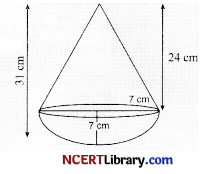
Explanation: Radius of sphere = Radius of cone
∴ Height of cone = Total height of toy – Radius of sphere
= (31 – 7) cm
= 24 cm.
Question 19.
DIRECTION: In the question number 19 and 20, a statement of assertion (A) is followed by a statement of Reason (R).
Choose the correct option
(a) Both assertion (A) and reason (R) are true and reason (R) is the correct explanation of assertion (A)
(b) Both assertion (A) and reason (R) are true and reason (R) is not the correct explanation of assertion (A)
(c) Assertion (A) is true but reason (R) is false.
(d) Assertion (A) is false but reason (R) is true.
Statement A (Assertion): ABC is an isosceles right triangle, right angled at C, then AB2 = 3AC2. Statement R (Reason): In an isosceles triangle ABC, if AC = BC and AB2 = 2AC2, then ZC = 90°.
Answer:
(d) Assertion is false but the Reason is true.
Explanation: For the assertion, by applying the Pythagoras theorem in the right angle triangle ABC, we get
AB2 = AC2 + BC2
= AC2 + AC2 [∵ BC = AC]
= 2AC2
So, the assertion is proved to be false.
For reason, by applying the Pythagoras theorem
AB2 = 2AC2 = AC2 + AC2 = AC2 + BC2
.’. ∠C = 90° (by converse of Pythagoras theroem)
So, the given statement in the reason is true.
Question 20.
Statement A (Assertion): The area enclosed by a chord and the major arc is major segment.
Statement R (Reason): If a circle is divided into three equal arcs, then each is a major arc.
Answer:
(c) Assertion is true but the Reason is false.
Explanation: For assertion, the area enclosed by a sector is proportional to the arc length of the sector.
So, A= \(\frac { RL }{ 2 }\), A = area, R= radius and L = arc length.
Hence, the resulting enclosed area is a major segment if it is a major arc.
So assertion is true.
For reason,
We basically denote an arc as a major arc when it is greater than the semicircle and if we divide a circle into 3 arc each of it will be less than a semicircle so it is a minor arc.
Section – B
Questions 21.
From your pocket money, you save ₹ 1 on day one, ₹ 2 on day two, ₹ 3 on day three and so on. How much money will you save in the month of March 2008?
OR
How many two-digit numbers are divisible by 6?
Answer:
Here, 1, 2,3,4, …, 31 form an A.P.
Where a = 1,d = 1 and n = 31 [∵ Number of days in March = 31]
We know that,
Sn = \(\frac { n }{ 2 }\) [2a + (n – 1)d]
S31 = \(\frac { 31 }{ 2 }\) [2 × 1 + (31 – 1)1]
= \(\frac { 31 }{ 2 }\) [2 + 30]
= \(\frac { 31 × 32 }{ 2 }\) = 496
Hence, savings in the month of march 2008 is ₹496.
OR
Two-digit numbers divisible by 6 are
12, 18, 24, …………, 96
We observe that the above series is an A.P.
Where a = 12,d = 6,an = 96
Now, we know that an – a + (n -1) d
⇒ 96 = 12 + (n -1) 6
⇒ 84 = (n -1) 6
⇒ n – 1 = 14
⇒ n = 15
Hence, number of two-digit numbers divisible by 6 are 15. Ans.
![]()
Question 22.
D and E are points on sides AB and AC of triangle ABC such that DE || BC. If AD = 2.4 cm, DB = 3.6 cm and AC = 5 cm, find AE.
OR
In △DEW, AB || EW. If AD = 4 cm, DE = 12 cm and DW = 24 cm, then find the value of DB.
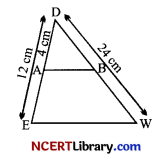
Answer:
Given : DE || BC, AD = 2.4 cm, DB = 3.6 cm and AC = 5 cm
In △ABC, DE || BC
∴ \(\frac{\mathrm{AD}}{\mathrm{DB}}\) = \(\frac{\mathrm{AE}}{\mathrm{CE}}\) [By basic proportionality theorem]
⇒ \(\frac{\mathrm{AD}}{\mathrm{DB}}\) = \(\frac{A E}{A C-A E}\)
⇒ \(\frac{2.4}{3.6}\) = \(\frac{\mathrm{AE}}{5-\mathrm{AE}}\)
⇒ \(\frac { 2 }{ 3 }\) = \(\frac{\mathrm{AE}}{5-\mathrm{AE}}\)
⇒ 3AE = 10 – 2AE
⇒ 3AE + 2AE = 10
⇒ AE = \(\frac { 10 }{ 5 }\)
∴ AE = 2 cm.
OR
Given, AD = 4 cm, DE = 12 cm and DW = 24 cm.
Let BD = x cm
Since, BW = DW – BD
Then, BW = (24 – x) cm.
Similarly, AE = 12 – 4 = 8 cm
In △DEW, AB || EW
∴ \(\frac{\mathrm{AD}}{\mathrm{AE}}\) = \(\frac{\mathrm{BD}}{\mathrm{BW}}\) [thales’ theroem]
⇒ \(\frac{4}{12-4}\) = \(\frac{x}{24-x}\)
⇒ 8x = 96 – 4x
⇒ 12x = 96
⇒ x = \(\frac{96}{12}\) = 8
∴ DB = 8 cm
Question 23.
All cards of ace, jack and queen are removed from a deck of playing cards. One card is drawn at random from the remaining cards. Find the probability that the card drawn is :
(i) a face card
(ii) not a face card.
Answer:
Total number of cards when aces, jacks and queens are removed
= 52 – 3 × 4
⇒ n(S) = 40
(i) Let E be the event that card drawn is a face card.
∴ n(E) = 4
P(E) = \(\frac{n(E)}{n(S)}\)
= \(\frac{4}{40}\) = \(\frac{1}{10}\)
(ii) Let Ē be the event that card drawn is non-face card.
Then P(Ē) = 1 =- P(E)
= 1 – \(\frac{1}{10}\) = \(\frac{9}{10}\)
Question 24.
Can the number 6n, n being a natural number, end with the digit 5? Give reason.
Answer:
We have, 6n = 2n × 3n
For any number ending with 5, the prime factor 5 should be there in its prime factorisation. But 6n has only 2 and 3 as prime factors. Therefore, 6n can never end with digit 5, for any natural number n.
Question 25.
A 5 m wide cloth is used to make a conical tent of base diameter 14 m and height 24 m. Find the cost of cloth used at the rate of ₹ 25 per m. [use π = \(\frac { 22 }{ 7 }\)
Answer:
Given, width of cloth = 5 m
Base diameter of tent = 14 m
∴ Radius = \(\frac { 14 }{ 2 }\) =7 cm
Height = 24 m
Slant height of cone, l = \(\sqrt{h^2+r^2}\)
= \(\sqrt{(24)^2+(7)^2}\)
= \(\sqrt{576+49}\) = \(\sqrt{625}\) = 25 cm
Let the length of the cloth be l’ m.
∴ Curved surface area of cone = Area of cloth
⇒ πrl = l’ × b
⇒ \(\frac { 22 }{ 7 }\) × 7 × 25 = l’ × 5
⇒ 22 × 25 = l × 5
⇒ l’ = \(\frac{22 \times 25}{5}\) m
⇒ l’ = 110 m
Thus, total cost of the cloth = ₹ (25 × 110) = ₹2750.
Section – C
Question 26.
(i) O is any point inside a rectangle ABCD. Prove that: OB2 + OD2 = OA2 + OC2.
(ii) If OB = 6 cm, OD = 8 cm, OA = 5 cm, find the length of OC.
Answer:
Let QP || AD || BC be perpendicular to AB and CD and pass through O.
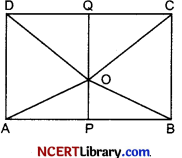
So, QO is the altitude of △COD and OP is the altitude of △BOA.
(i) Now, OB2 = OP2 + PB2 [Pythagoras theorem] ….(i)
OA2 = OP2 + AP2 [Pythagoras theorem] ….(ii)
OC2 = OQ2 + QC2 [Pythagoras theorem] ….(iii)
OD2 = OQ2 + DQ2 [Pythagoras theorem] ….(iv)
Thus, OB2 + OD2 = OQ2 + DQ2 + OP2 + PB2
⇒ OB2 + OD2 = OQ2 + PB2 + DQ2 + OP2
⇒ OB2 + OD2 = OQ2 + QC2 + AP2 + OP2 [∵ AP = DQ and PB = QC; opposite sides of rectangle]
⇒ OB2 + OD2 = OC2 + OA2 [From (ii) and (iii)]
(ii) ∵ OB2 + OD2 = OC2 + OA2
Let OC = x cm
⇒ (6)2 + (8)2 = x2 + (5)2
⇒ 36 + 64 = x2 + 25
⇒ x2 + 25 = 100
⇒ x2 = 75
⇒ x = 5√3 cm
Question 27.
If the sum of n terms of an A.P. is 4n – n2, what is the 10th term and the nth term?
Answer:
Given : Sn = 4n – n2
For n = 1, S1 = 4 × 1 – 12 = 3 = a1
For n = 2, S2 = 4 × 2 – 22 = 4 = a1 + a2
⇒ a2 = 3; a2 = 4
Now, a1 + a2 = 4
Now, 3 + a2 = 4
a2 = 1
Also, d = a2 – a1 = 1 – 3 = – 2
Now, a10 = a + 9d = 3 + 9(2) = 15
and an = a + (n – 1)d
= 3 + (n – 1)(- 2)
= 3 – 2n + 2
= 5 – 2n
![]()
Question 28.
For what value of ‘p’ will the following pair of linear equations have infinitely many solutions :
px + 3y = p – 3,
12x + py =p
OR
Solve for x and y: \(\frac { 5 }{ x }\) + \(\frac { 1 }{ y }\) = 2 and \(\frac { 6 }{ x }\) – \(\frac { 3 }{ y }\) = 1; x,y ≠ 0.
Answer:
Given equations are, px + 3y = p – 3
and 12x + py = p
On comparing the given equations with a1x + b1y + C1 = 0 and a1x + b2y + C2 = 0, respectively, we get
a1 = p; b1 = 3; c1 = – (p – 3)
a2 = 12; b2 = p; c2 = – p
For infinitely many solutions,
\(\frac{a_1}{a_2}\) = \(\frac{b_1}{b_2}\) = \(\frac{c_1}{c_2}\)
⇒ \(\frac { p }{ 12 }\) = \(\frac { 3 }{ p }\) = \(\frac{-(p-3)}{-p}\)
⇒ \(\frac { p }{ 12 }\) = \(\frac { 3 }{ p }\) = \(\frac{p-3}{p}\)
⇒ \(\frac { p }{ 12 }\) = \(\frac { 3 }{ p }\)
⇒ p2 = 36
⇒ p2 – 3p = 3p
⇒ p = ± 6
\(\frac { 3 }{ p }\) = \(\frac{p-3}{p}\)
⇒ p2 – 6p = 0
⇒ p (p – 6) = 0
⇒ p = 0 or p = 6
The above condition is satisfied, if p = 6
So, p = 6
OR
Given equations are
\(\frac { 5 }{ x }\) = \(\frac { 1 }{ y }\) = 2 …(i)
and \(\frac { 6 }{ x }\) = \(\frac { 3 }{ y }\) = 1 …(ii)
Let \(\frac { 1 }{ x }\) = a and \(\frac { 1 }{ y }\) = b
∴ The equations (i) and (ii) becomes
5a + b = 2 …(i)
and 6a – 3b = 1 ….(iv)
Multiplying equation (iii) by 3 and adding it to equation (iv), we get
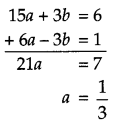
Putting the value of a in equation (iv), we get
6 × \(\frac { 1 }{ 3 }\) – 3b = 1
⇒ 2 – 3b = 1
⇒ -3b = 1 – 2
⇒ b = \(\frac { 1 }{ 3 }\)
Now, x = \(\frac { 1 }{ a }\) = \(\frac { 1 }{ 1/3 }\) = 3
and y = \(\frac { 1 }{ b }\) = \(\frac { 1 }{ 1/3 }\) = 3
∴ x = 3 and y = 3
Question 29.
In the given figure, the incircle of △ABC touches the sides BC, CA and AB at D, E and F respectively. If AB = AC, show that BD = CD.
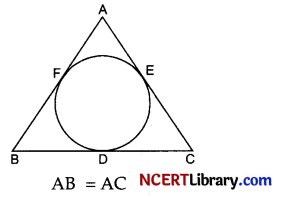
Answer:
Given : In △ABC,
We know that tangents drawn from an external point are equal.
∴ AF = AE …(i)
BF = BD …(h)
CD = CE ….(iii)
Now, AB = AC [Given]
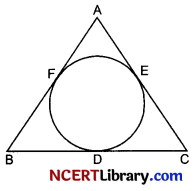
⇒ AF + BF = AE + CE
⇒ AF + BD = AE + DC [Using (ii) and (hi)]
⇒ BD = DC [∵ AF = AE]
Question 30.
Prove that the points A(- 3, 0), B(1, – 3) and C(4,1) are the vertices of an isosceles right triangle.
OR
For what value of ‘k’ the points A(1, 5), B(k, 1) and C(4,11) are collinear?
Answer:
Given points are A(- 3,0), B(1, – 3) and C(4,1).
Using distance formula,
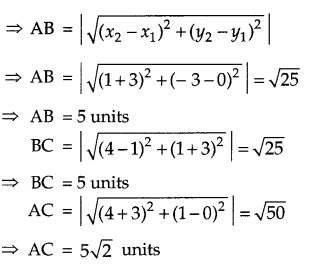
∵ AB = BC = 5 units
∴ △ABC is an isosceles triangle.
Also, AC2 = (5√2)2 = 50
and AB2 + BC2 = 25 + 25 = 50
⇒ AB2 + BC2 = AC2
∴ ∠B = 90° [By converse of pythagoras theorem]
Hence, △ABC is an isosceles right triangle.
OR
Given points are A(1, 5), B(k, 1) and C(4, 11).
For these points to be collinear, area formed by them should be zero i.e.,
|x1(y2 – y3) + x2(y3 – y1) + x3(y1 – y2) | = 0
⇒ | 1(1 – 11) + k(11 – 5) + 4(5 – 1) | = 0
⇒ |- 10 + 6k + 16 | = 0
⇒ 6k = – 6
⇒ k = -1
Question 31.
In what ratio does the point (\(\frac { 24 }{ 11 }\), y) divide the line segment joining the points P(2, -2) and Q(3, 7)? Also find the value of y.
Answer:
Let the point A(\(\frac { 24 }{ 11 }\), y) divides the line-segment PQ in ratio k : 1.
Using section formula,

Ax = \(\frac{3 k+2}{k+1}\)
⇒ \(\frac { 24 }{ 11 }\) = \(\frac{3 k+2}{k+1}\)
⇒ 33k + 22 = 24k + 24
⇒ 33k + 24k = 24 – 22
9k = 2
⇒ k = \(\frac { 2 }{ 9 }\)
So, k : 1 ⇒ \(\frac { 2 }{ 9 }\) : 1 ⇒ 2 : 9
Hence, Point A divides PQ is ratio 2 : 9.
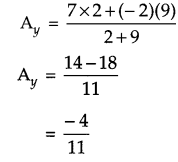
Section – D
Question 32.
Find the mode of the following frequency distribution:
| Class | 140-145 | 145-150 | 150-155 | 155-160 | 160-165 | 165-170 | 170-175 |
| Frequency | 3 | 7 | 10 | 7 | 6 | 2 | 3 |
OR
The table below gives the distribution of villages under different heights from sea level in a certain region.
| Heights | No. of village |
| 200 | 142 |
| 600 | 265 |
| 1000 | 560 |
| 1400 | 271 |
| 1800 | 89 |
| 2200 | 16 |
Answer:
| Class | Frequency |
| 140-145 | 3 |
| 145-150 | 7 f0 |
| l 150-155 | 10 fm |
| 155-160 | 7 f1 |
| 160-165 | 6 |
| 165-170 | 2 |
| 170-175 | 3 |
Modal class = Class with highest frequency = 150 – 155
Mode = l + \(\frac{f_m-f_0}{2 f_m-f_0-f_1}\) × h
Here, l = 150, fm = 10, f0 = 7, h = 5
∴ Mode = 150 + \(\frac{10-7}{20-7-7}\) × 5
= 150 + \(\frac { 3 }{ 6 }\) × 5
= 150 + 2.5 = 152.5
OR
Answer:
Compute the mean height of the region.
| Height (xi) | No. of villages | ui = \(\frac{x_i-\mathbf{A}}{\boldsymbol{h}}\) | fi ui |
| 200 | 142 | -3 | -426 |
| 600 | 265 | -2 | -530 |
| 1000 | 560 | -1 | -560 |
| A=1400 | 271 | 0 | 0 |
| 1800 | 89 | 1 | 89 |
| 2200 | 16 | 2 | 32 |
| f_i=1343 | Σ fi ui =-1395 |
Here, A = 1400, h = 400
we know that, Mean = A + \(\left\{\frac{\Sigma f_i u_i}{\Sigma f_i}\right\} \times h\)
= 1400 + \(\frac{-1395}{1343}\) × 400
= 1400 – 415.49
= 984.51.
Question 33.
(a) In the figure, D and E are points on sides AB and AC such that DE || BC. Find the length of DE.
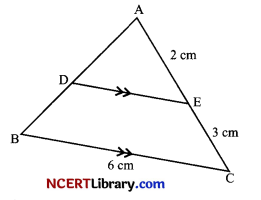
(b) In △ABC, D and E are mid-points of AC and BC respectively such that DE || AB. If AD = 2x, BE = 2x – 1, CD = x + 1 and CE = x – 1, then find the value of x.
Answer:
(a) Given: In △ABC, DE || BC, AE = 2 cm, BC = 6 cm, EC = 3 cm.
To prove: △ADE ~ △ABC
Proof: ∠ADE = ∠ABC [Corresponding angles]
∠ADE = ∠ABC [Corresponding angles]
By AA criterion similarity, △ADE ~ △ABC
∴ \(\frac{\mathrm{AE}}{\mathrm{AC}}\) = \(\frac{\mathrm{DE}}{\mathrm{BC}}\)
Now, AC = AE + EC
= 2 + 3 = 5 cm
Thus, AC = 5 cm
Put the value of AC in equation (i),
\(\frac { 2 }{ 5 }\) = \(\frac { DE }{ 6 }\)
DE = \(\frac { 2 × 6 }{ 5 }\)
= 2.4 cm
(b) Given, DE || AB
So, \(\frac{\mathrm{AD}}{\mathrm{CD}}\) = \(\frac{\mathrm{BE}}{\mathrm{EC}}\)
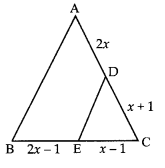
⇒ \(\frac{2 x}{x+1}\) = \(\frac{2 x-1}{x-1}\)
⇒ 2x(x – 1) = (x + 1) (2x – 1)
⇒ 2x2 – 2x = 2x2 + 2x – x – 1
⇒ – 2x = x – 1
⇒ 1 = 3x
or x = \(\frac { 1 }{ 3 }\)
![]()
Question 34.
Determine an A.P. whose 3rd term is 16 and when 5th term is subtracted from the 7th term, we get 12.
OR
Find the sum of all three-digit numbers which leave the remainder 3 when divided by 5.
Answer:
Let the first term of A.P. be a and common difference be d.
Given, a3 = 16 and a72 – a5 = 12
So, a + 2d =16 …(i)
and a + 6d – (a + 4d) = 12
⇒ a + 6d – a – 4d = 12
⇒ 2d = 12
.’. d = 6 ….(ii)
Putting the value of d from equation (ii) in equation (i), we get
a + 2 × 6 =16
⇒ a =16 – 12
⇒ a = 4
Hence the required A.P. is : 4,10,16,22,…
OR
Smallest 3-digit number which leaves the remainder 3 when divided by 5 = 103 Greatest 3-digit number which leave the remainder 3 when divided by 5 = 998 Hence, the series is 103,108,113,118,…, 998 We observe that the above series is an A.P.
We observe that the above series is an A.P.
Where a = 103, d = 5, an = 998
We know that, an = a + (n – 1 )d
⇒ 998 = 103 + (n – 1) 5
⇒ 998 = 103 + 5n – 5
⇒ 998 = 98 + 5n
⇒ 5n = 998 – 98 = 900
⇒ n = 180
Now, Sn = \(\frac { n }{ 2 }\) [a + an]
= \(\frac { 108 }{ 2 }\) [103 + 998] = 90 × 1101 = 99090
Hence, sum of three-digit numbers which leave the remainder 3 when divided by 5 is 99090.
Question 35.
If the centre of a circle is O and radius 3 cm, then draw two tangents from a point A outside the circle such that the distance between the centre of the circle O and the point A outside the circle is 9 cm. Prove that:
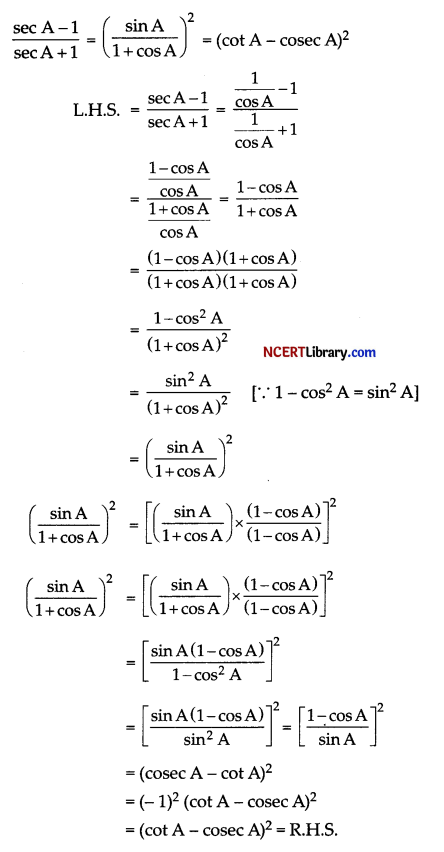
Section – E
Question 36.
Last night a big strom hit the city of Cuttack. Wind blew with the speed more than 200 km/hr. Many trees got uprooted, pillars broken. Many places in the city got darken as there was no electricity. An electrician was called to repair the faulty wires. He has to repair an electric fault on a pole of height 5 m. He needs to reach a point 1.3 m below the top of the pole to undertake a repair work as shown in figure.
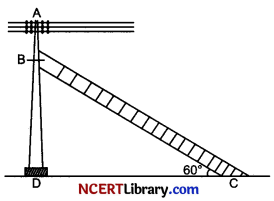
(i) If the ladder is inclined at 60°. Then find the length of the ladder required.
OR
How far the foot of the ladder should be placed from the foot of the pole?
(ii) At what angle should the ladder of height 10 m to be placed if he has to reach the top of the electric pole?
(iii) Upto what length a ladder of height 4√2 m reaches the pole inclined at an angle of 45°?
Answer:
(i) Given, Height of the pole = 5 m
Height to be reached = 5 – 1.3 = 3.7 m
Angle of elevation = 60°
In △BDC, Height of ladder = BC
sin 60° = \(\frac{\mathrm{BD}}{\mathrm{BC}}\)
\(\frac { √3 }{ 2 }\) = \(\frac{3.7}{B C}\)
BC = \(\frac{3.7 \times 2}{\sqrt{3}}\) = \(\frac{7.4}{\sqrt{3}}\) = \(\frac{7.4}{\sqrt{3}}\) × \(\frac{\sqrt{3}}{\sqrt{3}}\)
= \(\frac{7.4 \sqrt{3}}{3}\) m
OR
tan 60° = \(\frac{\mathrm{BD}}{\mathrm{DC}}\)
√3 = \(\frac{\mathrm{3.7}}{\mathrm{DC}}\)
DC = \(\frac { 3.7 }{ √3 }\)
= \(\frac{3.7 \times \sqrt{3}}{3}\) = 1.23√3 m
(ii) Height of pole = 5 m
Height of ladder = 10 m
Angle of inclination = \(\frac { 5 }{ 10 }\) = \(\frac { 1 }{ 2 }\) = sin 30°
(iii) Length of ladder = 4√2 m
Angle of inclination = 45°
Height it can reach is given by,
sin 45° = \(\frac { Height reached }{ Length of ladder }\)
\(\frac { 1 }{ √2 }\) = \(\frac { Height reached }{ 4√2 }\)
Height that can be reached = \(\frac { 4√2 }{ √2 }\) = 4 m
Question 37.
Snehal throws a party in her house. For the party she has to serve snacks and juice to her guests. She has a big jar of diameter 14 cm and height 42 cm filled with juice. She has two type of glasses for serving juice of cylindrical shape. Glass A with diameter 7 cm and height 10 cm and glass B with diameter 7 cm and height 12 cm.
Based on the above information answer the questions that follows :
(i) What is the capacity of juice jar?
(ii) If the juice is to served in glass B. Then how many guest will be served?
OR
Which glass has more capacity glass A or glass B?
(iii) Approximately how many guests can be served using glass A?
Answer:
(i) Since, jar is of cylindrical shape. So the capacity of jar is given by volume of cylinder.
Volume of cylinder = πr2h
Radius of jar (r) = \(\frac { 14 }{ 2 }\) = 7 cm
Height of jar (h) = 42 cm
Volume = \(\frac { 22 }{ 7 }\) × 7 × 7 × 42 = 6,468 cm2
(ii) Dimensions of glass B are
Radius of glass = \(\frac { 7 }{ 2 }\) cm
Height of glass = 12 cm
Capacity of each glass = \(\frac { 22 }{ 7 }\) × \(\frac { 7 }{ 2 }\) × \(\frac { 7 }{ 2 }\) × 12 = 462 cm3
Number of guests served = \(\frac { Volume of juice jar }{ Volume of each glass }\)
\(\frac { 6468 }{ 462 }\) = 14
OR
Capacity of glass B is 462 cm3
Capacity of glass A = πr2h
= \(\frac { 22 }{ 7 }\) × \(\frac { 7 }{ 2 }\) × \(\frac { 7 }{ 2 }\) × 10 = 385 cm3
.’. It is clear that glass B has more capacity.
(iii) Volume of juice jar = 6468 cm3
Volume of glass A = 385 cm3
Number of guests served = \(\frac { 6468 }{ 385 }\) = 16.8 ≃ 17
Question 38.
Due to covid-19 and Lockdown every company is going through many crises. They have to cut-down the salaries of few employees. Before doing so they decided to have the survey of the salaries of company workers. In survey of salaries of workers of a company following data is collected :
| Salary (in thousands | 5-10 | 10-15 | 15-20 | 20-25 | 25-30 |
| No. of person | 50 | 133 | 63 | 16 | 8 |
Based on the above information answer the following questions.
(i) What will be the upper limit of modal class?
(ii) Estimate the mean salary of the workers.
OR
How many workers have salary more than ? 20,000?
(iii) Class mark of class interval 20-25 is equal to:
Answer:
(i) Modal class is the class with maximum frequency i.e. 133. Hence upper limit of modal class is 15.
(ii)
| Class interval | fi | xi | fi xi |
| 5-10 | 50 | 7.5 | 375 |
| 10-15 | 133 | 12.5 | 1662.5 |
| 15-20 | 63 | 17.5 | 1,102.5 |
| 20-25 | 16 | 22.5 | 360 |
| 25-30 | 8 | 27.5 | 220 |
| Σfi = 270 | Σ fi xi = 3720 |
Mean = \(\frac{\Sigma f_i x_i}{\Sigma f_i}\)
= \(\frac { 3720 }{ 270 }\) = 13.778
Mean salary = 13.778 × 1000 = ₹ 13778
OR
No. of workers have salary more than ₹ 20,000 = 16 + 8 = 24
(iii) Class mark of a class interval is equal to \(\frac{ 1 }{ 2 }\) (lower limit + upper limit)
= \(\frac{ 1 }{ 2 }\) (20 + 25)
= \(\frac{ 1 }{ 2 }\) (45) = 22.5